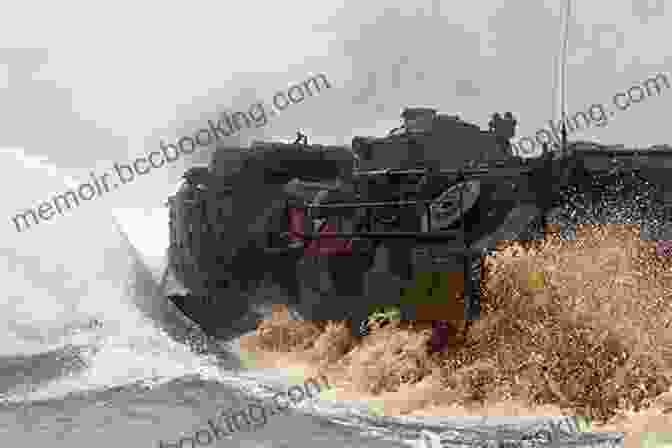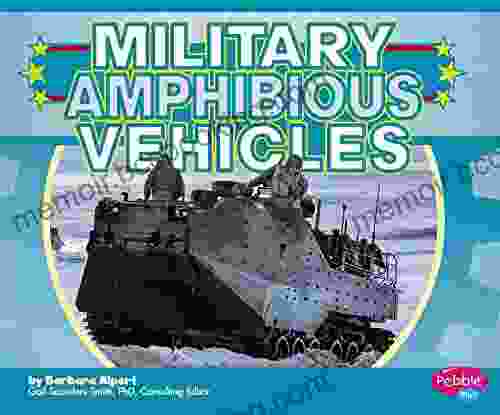Discover the Ingenious Engineering of Military Amphibious Vehicles: Military Machines


In the realm of military engineering, amphibious vehicles stand as extraordinary feats of innovation and adaptability. These remarkable machines embody the fusion of land and sea capabilities, seamlessly transitioning between different terrains with remarkable efficiency. Their distinct design and specialized systems empower military forces to traverse challenging landscapes and waterways, expanding their operational horizons. In this comprehensive article, we delve into the fascinating world of military amphibious vehicles, exploring their history, design principles, and groundbreaking applications.
5 out of 5
| Language | : | English |
| File size | : | 29603 KB |
| Print length | : | 24 pages |
| Screen Reader | : | Supported |
Historical Evolution of Amphibious Vehicles
The concept of amphibious vehicles dates back to ancient times, with early iterations emerging as primitive rafts and boats. However, it was during World War II that amphibious vehicles truly came into their own. The pressing need for efficient amphibious landings led to significant advancements in design and engineering, culminating in iconic vehicles like the Landing Vehicle Tracked (LVT) and the Sherman Duplex Drive (DD) tank.
Post-war, the development of amphibious vehicles continued with renewed vigor. Advanced technologies and materials propelled the creation of more versatile and capable platforms, such as the AAV7A1 Assault Amphibious Vehicle and the EFV Expeditionary Fighting Vehicle. Today, military amphibious vehicles play a vital role in modern warfare, providing armies with unparalleled amphibious capabilities.
Design Principles and Engineering Marvels
Military amphibious vehicles embody a complex interplay of design principles and engineering ingenuity. Their unique construction allows them to navigate both land and water with equal proficiency. Key design elements include:
Floatation Systems:
Amphibious vehicles feature specialized flotation systems that enable them to stay afloat in water. These systems can be in the form of watertight compartments, sponsons, or inflatable buoyancy chambers. They provide the necessary buoyancy to support the vehicle's weight and ensure stability on water.
Propulsion Systems:
To traverse water, amphibious vehicles employ various propulsion mechanisms. Propellers, water jets, or paddle wheels are commonly used to generate thrust and propel the vehicle forward. These systems optimize hydrodynamic efficiency and maneuverability in aquatic environments.
Traction Systems:
Amphibious vehicles are equipped with robust traction systems that provide grip and control on land. Tracked systems, wheeled configurations, or a combination of both ensure the vehicle's mobility across diverse terrains, including sand, mud, and uneven surfaces.
Transition Mechanisms:
One of the defining characteristics of amphibious vehicles is their ability to transition seamlessly between land and water. This is achieved through retractable landing gear, adjustable buoyancy systems, or special ramps and flotation screens. Transition mechanisms enable the vehicle to enter and exit water smoothly and efficiently.
Operational Applications and Tactical Advantages
Military amphibious vehicles play a crucial role in a wide range of military operations, including:
Amphibious Landings:
Amphibious vehicles are indispensable for conducting amphibious landings, where forces are deployed from ships directly onto enemy-held shores. They provide a means to transport troops, equipment, and supplies from sea to land, establishing a beachhead and initiating ground operations.
Coastal Defense:
Amphibious vehicles enhance coastal defense capabilities by enabling rapid deployment of forces to defend against potential threats. Their ability to operate in both land and water environments makes them ideal for patrolling coastlines, responding to amphibious attacks, and securing strategic locations.
Special Operations:
Military amphibious vehicles are employed in special operations missions due to their versatility and stealth capabilities. They can infiltrate enemy territory via waterways or marshes, carrying out covert operations or precision strikes. Their ability to transition between land and water undetected provides a significant tactical advantage.
Disaster Relief and Humanitarian Assistance:
In addition to combat roles, amphibious vehicles are also utilized for disaster relief and humanitarian assistance operations. Their ability to navigate flooded areas, cross damaged bridges, and transport essential supplies makes them invaluable for reaching remote or inaccessible regions during emergencies.
Noteworthy Examples of Military Amphibious Vehicles
Throughout history, several remarkable amphibious vehicles have emerged, leaving an indelible mark on military operations. Some notable examples include:
LVT (Landing Vehicle Tracked):
The LVT was a versatile amphibious vehicle used extensively by the Allied forces during World War II. It featured a tracked chassis, a watertight hull, and a rear-mounted propeller. The LVT played a pivotal role in amphibious landings, transporting troops and equipment ashore.
Higgins Boat (LCVP):
The Higgins Boat was a smaller amphibious landing craft used by the United States Navy during World War II. It was designed by Andrew Higgins and became synonymous with the D-Day landings. The Higgins Boat's open design and shallow draft allowed it to navigate close to shore, facilitating troop deployment.
AAV7A1 Assault Amphibious Vehicle:
The AAV7A1 is a modern amphibious assault vehicle used by the United States Marine Corps. It is a fully armored, tracked vehicle that can transport a squad of Marines and their equipment. The AAV7A1 is known for its amphibious capabilities, high mobility, and firepower.
EFV Expeditionary Fighting Vehicle:
The EFV is a next-generation amphibious vehicle being developed by the United States Marine Corps. It is intended to replace the AAV7A1 and provide enhanced capabilities. The EFV is designed for high-speed amphibious operations and features advanced technologies such as water jet propulsion and a sophisticated combat system.
Military amphibious vehicles stand as a testament to the ingenuity and engineering prowess of human innovation. Their unique design and remarkable capabilities allow armed forces to conquer both land and sea, expanding operational possibilities and enhancing military effectiveness. From the historic landing craft of World War II to the cutting-edge amphibious assault vehicles of today, these remarkable machines continue to shape the course of warfare and humanitarian assistance. As technology advances, we can expect even more advancements in amphibious vehicle design, pushing the boundaries of versatility and operational capabilities in the years to come.
5 out of 5
| Language | : | English |
| File size | : | 29603 KB |
| Print length | : | 24 pages |
| Screen Reader | : | Supported |
Do you want to contribute by writing guest posts on this blog?
Please contact us and send us a resume of previous articles that you have written.
 Book
Book Novel
Novel Page
Page Chapter
Chapter Text
Text Story
Story Genre
Genre Reader
Reader Library
Library Paperback
Paperback E-book
E-book Magazine
Magazine Newspaper
Newspaper Paragraph
Paragraph Sentence
Sentence Bookmark
Bookmark Shelf
Shelf Glossary
Glossary Bibliography
Bibliography Foreword
Foreword Preface
Preface Synopsis
Synopsis Annotation
Annotation Footnote
Footnote Manuscript
Manuscript Scroll
Scroll Codex
Codex Tome
Tome Bestseller
Bestseller Classics
Classics Library card
Library card Narrative
Narrative Biography
Biography Autobiography
Autobiography Memoir
Memoir Reference
Reference Encyclopedia
Encyclopedia Barbara Fox
Barbara Fox Ansel Hatch
Ansel Hatch Ariel Sharon
Ariel Sharon Arous Brocken
Arous Brocken Ari Fleischer
Ari Fleischer Arleta Pech
Arleta Pech Anita C Prieto
Anita C Prieto Anne K Brown
Anne K Brown B V Larson
B V Larson Aron Ralston
Aron Ralston Antoinette May
Antoinette May Amber Netting
Amber Netting Ann Marks
Ann Marks Armin A Brott
Armin A Brott Austen Szott
Austen Szott Ashley Emma
Ashley Emma Ann Hill Duin
Ann Hill Duin Assembil Books
Assembil Books Augusto Cury
Augusto Cury Baba Ifa Karade
Baba Ifa Karade
Light bulbAdvertise smarter! Our strategic ad space ensures maximum exposure. Reserve your spot today!

 Heath PowellUnlocking the Wisdom of Compassion and Mindfulness: Lessons from His Holiness...
Heath PowellUnlocking the Wisdom of Compassion and Mindfulness: Lessons from His Holiness... Roald DahlFollow ·8.9k
Roald DahlFollow ·8.9k Patrick HayesFollow ·19.3k
Patrick HayesFollow ·19.3k Eddie PowellFollow ·12.5k
Eddie PowellFollow ·12.5k Carson BlairFollow ·12k
Carson BlairFollow ·12k Howard PowellFollow ·16.7k
Howard PowellFollow ·16.7k Floyd PowellFollow ·14.2k
Floyd PowellFollow ·14.2k Ivan CoxFollow ·3.2k
Ivan CoxFollow ·3.2k George R.R. MartinFollow ·13.4k
George R.R. MartinFollow ·13.4k

 Brayden Reed
Brayden ReedTeach Your Child They Have No Self Worth And They Will...
By Dr. Jane Doe ...

 Shawn Reed
Shawn ReedUnveiling Centuries of Tradition: History of Childbirth...
Journey into the heart of the...

 Brady Mitchell
Brady MitchellProven Guidelines For Healthy Multiple Pregnancy
Congratulations on your...

 Dylan Mitchell
Dylan MitchellHarness the Power of Sleep for Optimal Health and...
In the fast-paced,...

 Herman Melville
Herman MelvilleAlexander Hamilton: The Revolutionary Who Shaped...
Alexander Hamilton was a...
5 out of 5
| Language | : | English |
| File size | : | 29603 KB |
| Print length | : | 24 pages |
| Screen Reader | : | Supported |












